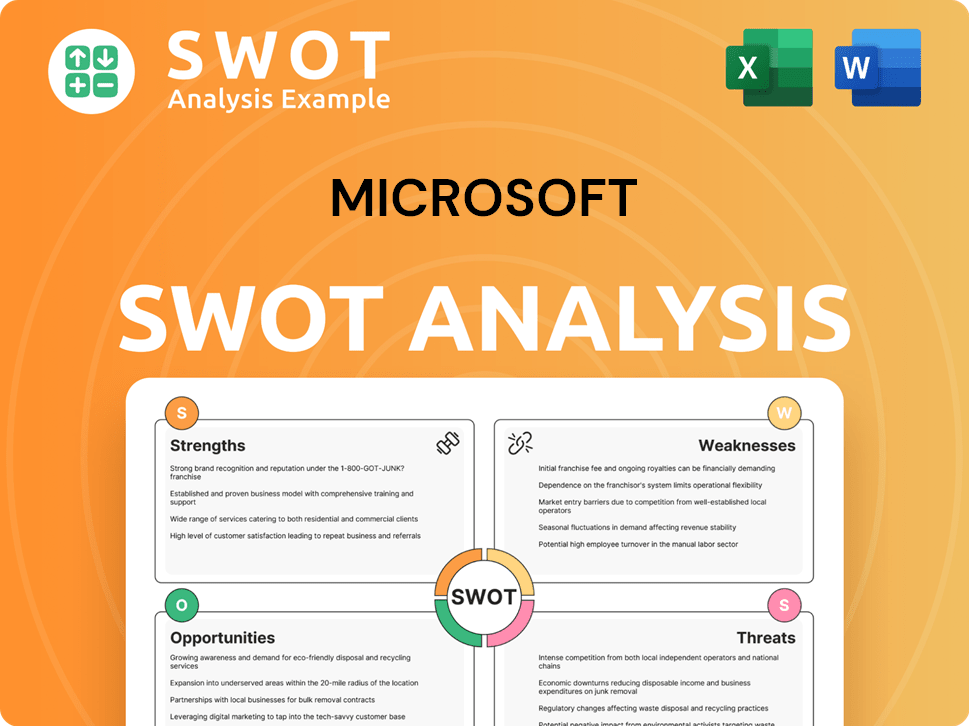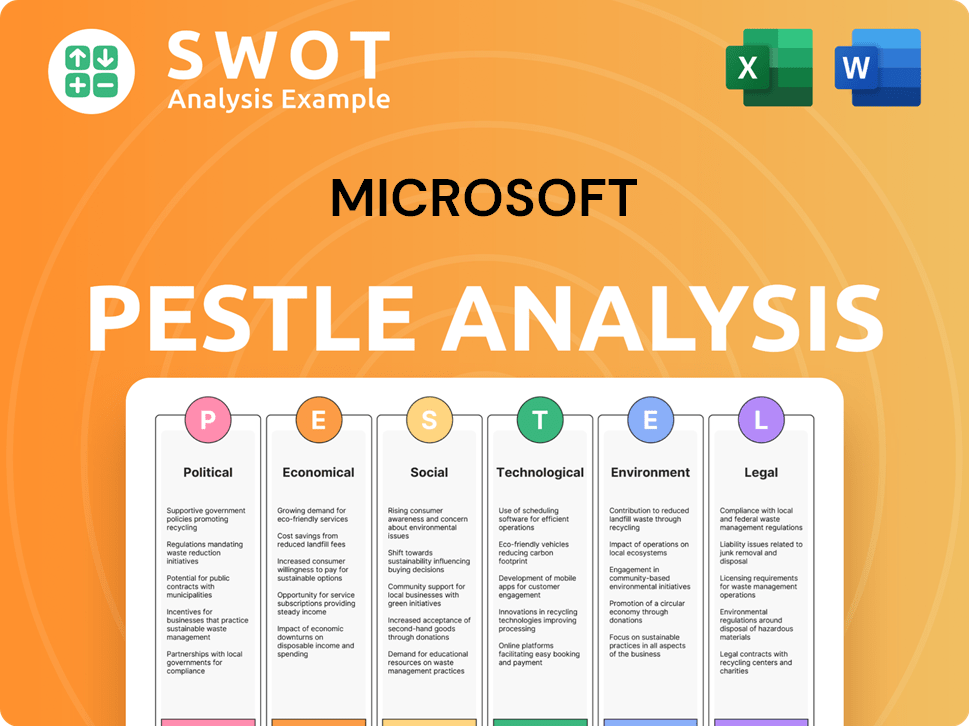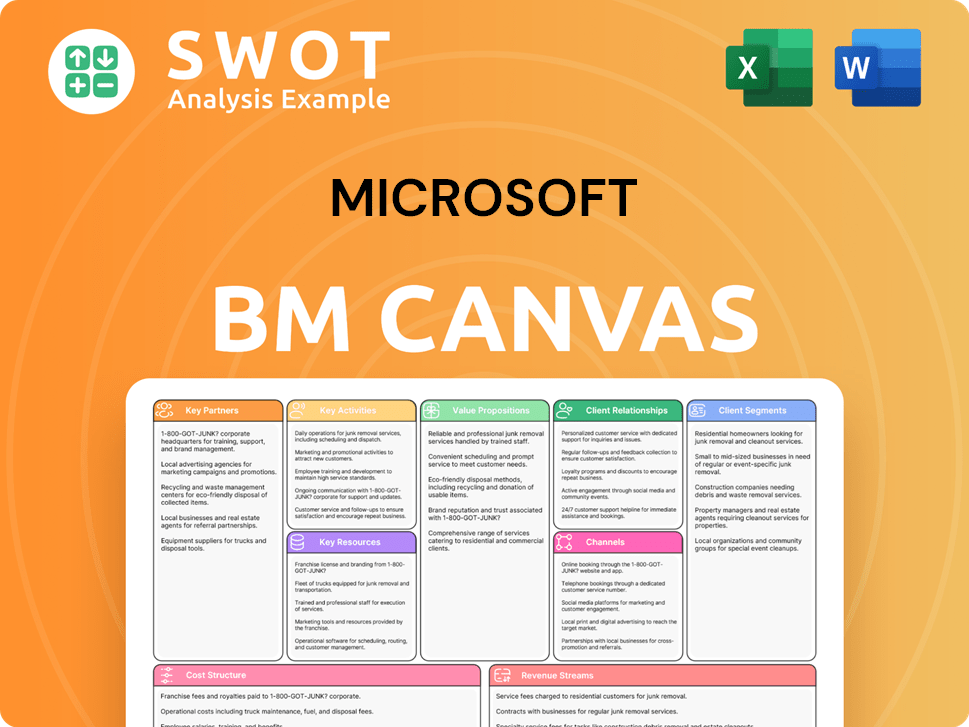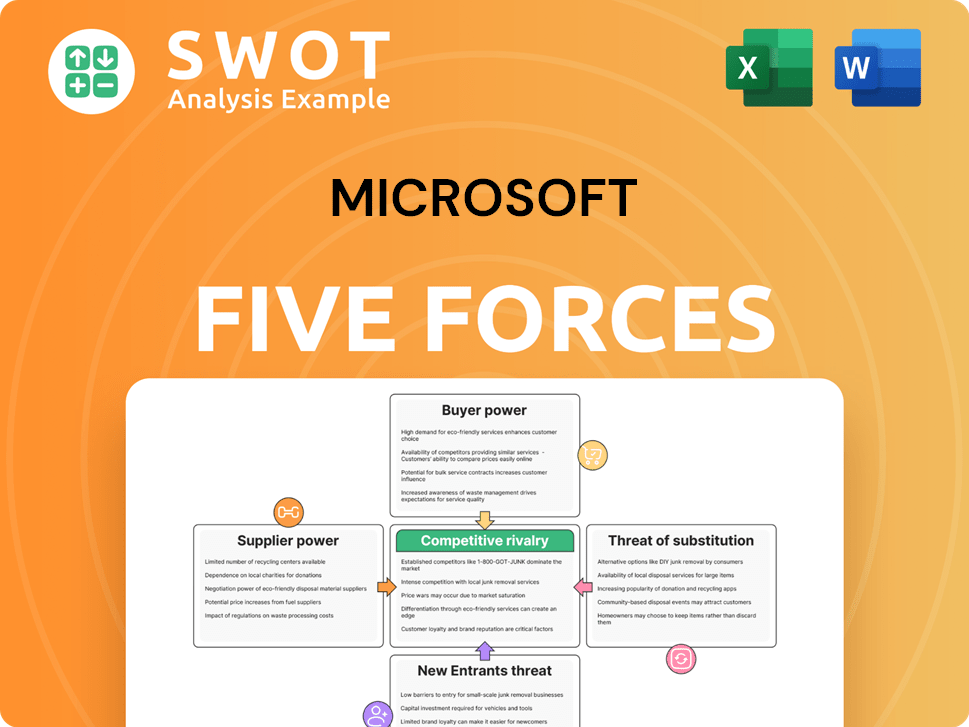Microsoft Bundle
What Drives Microsoft's Global Dominance?
Understanding a company's core principles is key to grasping its market position and future trajectory. Dive into the heart of a tech giant and explore the Microsoft SWOT Analysis, uncovering the driving forces behind its global influence. This analysis will reveal the very essence of Microsoft's strategy.

The Microsoft mission, vision, and core values are not just corporate jargon; they are the foundational pillars supporting its vast operations. Examining the Microsoft mission statement examples, we see how these principles shape its approach to innovation, customer engagement, and societal impact. Analyzing the Microsoft vision statement analysis provides insights into its long-term goals, while understanding Microsoft core values and principles offers a glimpse into its corporate culture.
Key Takeaways
- Microsoft's mission and vision provide a clear purpose for its continued success.
- Core values like respect, innovation, and AI guide operations and company culture.
- Alignment with guiding principles is crucial for future growth in the tech industry.
- Microsoft aims to empower individuals and organizations through its products.
Mission: What is Microsoft Mission Statement?
Microsoft's mission is 'to empower every person and every organization on the planet to achieve more.'
Delving into the essence of the Microsoft mission, we find a powerful statement that transcends mere business objectives. It's a commitment to global enablement through technology. This mission statement serves as the guiding light for all of Microsoft's endeavors, from product development to corporate social responsibility. Understanding this mission is crucial for anyone seeking to comprehend the Microsoft company's direction and impact.
The core of the Microsoft mission lies in its ambition to empower. This empowerment is not limited by geography or sector. It extends to every individual and every organization globally, signifying a universal scope.
The mission's value proposition is clear: to enable individuals and organizations to achieve more. This encompasses productivity gains, innovation, and overall advancement across various domains.
The mission is inherently customer-centric. It places the needs and aspirations of its users at the forefront, driving the development of user-friendly and impactful technologies.
Innovation is a key component of the mission. Microsoft consistently invests in research and development to create cutting-edge technologies that align with its mission to empower.
The mission extends beyond commercial success, encompassing a commitment to addressing societal challenges. Initiatives like 'AI for Good' exemplify this commitment.
The development of the Microsoft 365 suite, the Azure cloud platform, and AI-driven solutions are all examples of how Microsoft puts its mission into practice. These products and services are designed to help individuals and organizations reach their full potential.
The Microsoft mission statement examples are evident in its product offerings and strategic initiatives. For instance, the Azure cloud platform has seen substantial growth, with revenue increasing by 28% in the last quarter of 2024, reflecting its role in empowering organizations to innovate and scale. Microsoft's commitment to accessibility features in its products, such as Windows, also exemplifies its mission to empower everyone. The company's dedication to cybersecurity, with investments exceeding $20 billion over the past five years, further demonstrates its commitment to enabling secure and reliable technology for all. Microsoft's mission also influences its approach to sustainability, with the company aiming to be carbon negative by 2030, showcasing its commitment to a sustainable future. The mission is deeply intertwined with the company's Microsoft strategy, influencing all areas of its business.
The Microsoft vision is closely linked to its mission, envisioning a future where technology empowers everyone to achieve more. This vision is dynamic, adapting to the evolving technological landscape. The evolution of Microsoft's vision over time reflects its adaptability and commitment to innovation. Microsoft's mission statement for cloud computing, for example, focuses on providing a secure, reliable, and scalable platform for businesses and individuals. Moreover, Microsoft's vision for artificial intelligence is to make AI accessible and beneficial to all, driving advancements in various fields. The Microsoft core values and principles are essential in driving the company's mission. The company's commitment to diversity and inclusion, for example, reflects its mission to empower every person, regardless of their background. The role of Microsoft's core values in decision-making ensures that all actions align with its mission and vision. The Microsoft mission and its impact on society is substantial, with its technologies influencing how people work, communicate, and live. For a deeper understanding of how Microsoft approaches its market, consider exploring the Marketing Strategy of Microsoft.
Microsoft SWOT Analysis
- Complete SWOT Breakdown
- Fully Customizable
- Editable in Excel & Word
- Professional Formatting
- Investor-Ready Format

Vision: What is Microsoft Vision Statement?
Microsoft's vision is 'to democratize AI, making it accessible and beneficial for everyone.'
Let's delve into the core of Microsoft's aspirations. Understanding the Microsoft vision is crucial for grasping the company's strategic direction and its impact on the tech industry and beyond. This vision statement is not just a collection of words; it is a powerful declaration of intent, shaping the company's actions and influencing its future.
The Microsoft vision is inherently future-oriented, focusing on the transformative potential of Artificial Intelligence. It's a bold statement that sets the stage for innovation and positions Microsoft at the forefront of technological advancement. This forward-looking perspective is a cornerstone of Microsoft's strategy.
The vision emphasizes making AI accessible to all, not just a select few. This commitment to inclusivity is a key aspect of the Microsoft mission, aiming to empower individuals and organizations worldwide. This approach is designed to broaden AI's impact.
Microsoft's vision has a global scope, aiming to affect people across the world. This broad ambition reflects the company's desire to be a leading force in the AI revolution. This global perspective is central to the Microsoft strategy.
Microsoft's significant investments in AI, with an annual revenue run rate exceeding $13 billion (up 175% year-over-year as of Q2 FY25), demonstrate its commitment to achieving this vision. These investments show the company's dedication to making its vision a reality. This commitment is a key driver of the Microsoft culture.
The company's focus on integrating AI across its products and services, such as Microsoft Copilot, illustrates a clear path toward realizing its vision. This integration strategy is a practical step toward achieving its goals. Understanding the Microsoft mission requires recognizing this integration.
The vision aligns with the broader industry trend of AI adoption, positioning Microsoft to lead in this evolving landscape. This alignment ensures that Microsoft remains at the forefront of technological innovation. For more insights, consider reading about the Target Market of Microsoft.
In essence, the Microsoft vision is a call to action, a statement of purpose that drives the company's innovation and strategic direction. It reflects a deep understanding of the potential of AI and a commitment to making it a force for good in the world. This vision is a critical component of the Microsoft core values and principles.
Microsoft PESTLE Analysis
- Covers All 6 PESTLE Categories
- No Research Needed – Save Hours of Work
- Built by Experts, Trusted by Consultants
- Instant Download, Ready to Use
- 100% Editable, Fully Customizable

Values: What is Microsoft Core Values Statement?
Understanding the core values of a company provides crucial insights into its operational ethos and strategic direction. Microsoft, a global technology leader, has established a set of core values that guide its actions and shape its corporate culture.
Respect is a fundamental value at Microsoft, emphasizing the importance of treating everyone with dignity and valuing diverse perspectives. This value is evident in the company's commitment to fostering an inclusive and supportive work environment, as well as in its approach to customer relations, where listening to and understanding customer needs are prioritized.
Integrity is another cornerstone of Microsoft's values, representing a commitment to honesty, transparency, and ethical behavior. This value is crucial for building trust with customers, partners, and stakeholders. It influences business practices through adherence to ethical guidelines and transparent communication, ensuring that all interactions are conducted with the highest standards of moral and ethical conduct.
Accountability is a key value, signifying the taking of ownership of actions and commitments. This value is reflected in business practices through clear responsibilities and a focus on delivering results. Microsoft's commitment to accountability extends to its corporate social responsibility and environmental goals, ensuring that the company is transparent and responsible in its impact on the world.
Innovation is central to Microsoft's success and involves a commitment to leading-edge technology and continuous improvement. This value drives product development, with significant investments in R&D, totaling $27.2 billion in fiscal year 2024. Microsoft consistently seeks to create new technologies and solutions to meet the evolving needs of its customers and the market.
These core values are integral to Microsoft's identity, influencing its Owners & Shareholders of Microsoft, its approach to innovation, and its commitment to social responsibility. Understanding these values provides a deeper insight into the company's strategic direction and its impact on the tech industry and society. Next, we will explore how the Microsoft mission and vision influence the company's strategic decisions.
How Mission & Vision Influence Microsoft Business?
Microsoft's Microsoft mission and Microsoft vision are not just aspirational statements; they are fundamental drivers that shape the company's strategic direction. These statements guide key decisions, influencing everything from product development to market positioning, ensuring alignment with its long-term goals.
The Microsoft mission to "empower every person and every organization on the planet to achieve more" is the cornerstone of its strategic initiatives. This mission is evident in the company's focus on developing tools and platforms that enhance productivity, foster innovation, and promote accessibility across various sectors. This is a direct reflection of Microsoft's mission statement examples in action.
- Cloud Computing & AI: Azure, Microsoft's cloud platform, and its integration of AI technologies are prime examples of how the company empowers businesses and individuals.
- Productivity Enhancement: The development of Microsoft 365 Copilot, which leverages AI to boost productivity, directly aligns with the mission.
- Strategic Acquisitions: Acquisitions like Activision Blizzard King expand Microsoft's reach, offering entertainment and services to a broader audience, thereby empowering more people.
- Partnerships: Collaborations with various organizations and sectors reflect the mission's focus on global impact and empowerment.
The continued expansion of Azure is a clear example of the Microsoft mission in action. Azure provides scalable and innovative solutions, empowering businesses of all sizes to achieve more. This is a key component of Microsoft's mission statement for cloud computing.
Integrating AI into products like Microsoft 365 Copilot is a direct response to the mission of empowering individuals and organizations. This integration enhances productivity and efficiency, aligning with Microsoft's vision for artificial intelligence.
The acquisition of Activision Blizzard King is a strategic move that aligns with the mission by expanding the reach of Microsoft's services. This acquisition empowers more people through gaming and entertainment, demonstrating how Microsoft's core values drive strategic decisions.
Partnerships with diverse organizations reflect the mission's focus on global impact and empowering different sectors. These collaborations help extend the reach of Microsoft's products and services, supporting the company's broader goals.
The success of the Microsoft mission is evident in key financial metrics. The Intelligent Cloud segment saw a 20% increase in FY24, with Azure growing by 30%. Microsoft Cloud revenue for Q3 FY25 was $42.4 billion, up 20% year-over-year.
The rapid growth of Microsoft's AI business, with an annual revenue run rate exceeding $13 billion, up 175% year-over-year, highlights the influence of the vision. This growth demonstrates how Microsoft's vision for the future of technology is being realized.
CEO Satya Nadella's emphasis on cloud and AI as essential inputs for business expansion, cost reduction, and accelerated growth directly echoes the Microsoft mission of empowering others. The Microsoft vision and Microsoft mission shape day-to-day operations by guiding product development priorities and long-term planning by informing strategic investments and market positioning. To further understand how Microsoft generates revenue and structures its business, consider exploring the analysis of Revenue Streams & Business Model of Microsoft. This alignment ensures that Microsoft's actions consistently reflect its core values and strategic objectives. The next chapter will delve into the Microsoft core values and how they contribute to the company's success.
Microsoft Business Model Canvas
- Complete 9-Block Business Model Canvas
- Effortlessly Communicate Your Business Strategy
- Investor-Ready BMC Format
- 100% Editable and Customizable
- Clear and Structured Layout

What Are Mission & Vision Improvements?
While Microsoft's current mission, vision, and core values provide a solid foundation, continuous improvement is crucial for sustained success in the dynamic tech industry. This section explores potential refinements to further strengthen Microsoft's guiding principles and ensure they remain relevant in the face of evolving technological and societal challenges.
A key improvement involves explicitly incorporating responsible technology and ethical AI development into the Microsoft mission or Microsoft vision. This would solidify Microsoft's commitment to these critical areas, reflecting the growing importance of ethical considerations in AI and the broader tech landscape. This could include specific language about developing AI that is fair, transparent, and accountable, addressing concerns about bias and misuse. For example, Microsoft has invested \$100 million in AI for Accessibility to empower people with disabilities, which could be a focus.
Another area for enhancement is the explicit inclusion of sustainability within the Microsoft mission or Microsoft vision. This aligns with the increasing global focus on environmental responsibility and Microsoft's ambitious sustainability goals, such as becoming carbon negative by 2030. This could involve emphasizing the development of sustainable products, reducing the environmental impact of its operations, and promoting the use of technology to address climate change. Microsoft's data centers are already 60% powered by renewable energy, a figure that could be highlighted.
Refining the Microsoft mission to explicitly address broader societal impacts and global challenges is another area for improvement. This could involve articulating a clearer commitment to using technology to solve pressing issues like healthcare, education, and economic inequality. This would go beyond general empowerment and demonstrate a proactive approach to leveraging technology for the greater good. For example, Microsoft's work in providing digital skills training to 25 million people worldwide could be a focus.
To ensure long-term relevance, Microsoft should continuously update its Microsoft vision to reflect emerging technologies and future trends, such as quantum computing and the metaverse. This proactive approach will help Microsoft stay ahead of the curve and maintain its position as a leader in the tech industry. Further insights into Microsoft's strategic direction can be found in the Growth Strategy of Microsoft.
How Does Microsoft Implement Corporate Strategy?
Implementing a company's mission, vision, and core values is crucial for translating strategic intent into tangible actions and outcomes. This implementation phase involves embedding these guiding principles into the company's operations, culture, and decision-making processes to ensure alignment and drive success.
Microsoft demonstrates its mission and vision through its product development, particularly in Microsoft 365 and Azure. These platforms directly empower individuals and organizations by providing tools for productivity, collaboration, and cloud computing. The company's significant investment in AI research and development, with a budget of $20 billion in 2023, and the integration of AI features across its product line exemplify the vision of democratizing AI, making it accessible to a wider audience.
- Microsoft 365: Continuous updates and new features, such as AI-powered tools in Word, Excel, and PowerPoint, reflect the mission to empower users with advanced capabilities.
- Azure: Ongoing expansion of services and infrastructure to support diverse customer needs, from small businesses to large enterprises, aligns with the vision of democratizing technology.
- AI Integration: Features like Copilot in various Microsoft products provide users with AI-driven assistance, enhancing productivity and accessibility.
- Research and Development: Microsoft's commitment to R&D, with a substantial portion dedicated to AI, ensures the company remains at the forefront of technological innovation.
Leadership plays a critical role in reinforcing Microsoft's mission, vision, and core values. CEO Satya Nadella frequently emphasizes the importance of empowerment, digital transformation, and the transformative potential of AI, embedding these concepts into the company culture. The mission and vision are communicated to stakeholders through various channels, including the company website, investor reports, and public statements, ensuring consistent messaging.
Microsoft's commitment to its core values is evident in its practices. The company actively promotes diversity and inclusion within its workforce, with initiatives aimed at creating a more equitable and representative environment. Furthermore, Microsoft invests significantly in renewable energy and waste reduction to meet its sustainability goals, demonstrating its commitment to environmental responsibility.
Microsoft has implemented formal programs and systems to ensure alignment between its stated values and actual practices. Core values are integrated into employee performance reviews and decision-making frameworks, ensuring that employees are evaluated not only on their results but also on how they achieve them. The 'Secure Future Initiative,' spearheaded by leadership, prioritizes security by design, default, and operation, reflecting the value of trustworthy computing.
Microsoft’s commitment to ethical AI development is another key implementation area. The company has established principles around fairness, transparency, and inclusivity in its AI development processes. This includes measures to mitigate bias in algorithms, ensure data privacy, and promote responsible use of AI technologies. Microsoft's efforts in this area are crucial for building trust and ensuring that AI benefits society as a whole. For instance, Microsoft's investment in responsible AI initiatives reached $1 billion by 2023.
Microsoft's mission and vision have a significant impact on society and the future of technology. By empowering individuals and organizations, the company contributes to economic growth, innovation, and social progress. Microsoft's focus on AI, cloud computing, and sustainability positions it to address some of the world's most pressing challenges. To understand the competitive landscape, one can explore the Competitors Landscape of Microsoft.
- Economic Impact: Microsoft's products and services support millions of jobs and contribute billions of dollars to the global economy.
- Innovation: The company's R&D efforts drive advancements in areas such as AI, cloud computing, and quantum computing.
- Social Progress: Microsoft's initiatives in areas such as accessibility, education, and environmental sustainability contribute to a better world.
- Future Trends: Microsoft is well-positioned to capitalize on emerging trends such as AI, the metaverse, and the Internet of Things.
Microsoft Porter's Five Forces Analysis
- Covers All 5 Competitive Forces in Detail
- Structured for Consultants, Students, and Founders
- 100% Editable in Microsoft Word & Excel
- Instant Digital Download – Use Immediately
- Compatible with Mac & PC – Fully Unlocked

Related Blogs
- What are Mission Vision & Core Values of Microsoft Company?
- What is Competitive Landscape of Microsoft Company?
- What is Growth Strategy and Future Prospects of Microsoft Company?
- How Does Microsoft Company Work?
- What is Sales and Marketing Strategy of Microsoft Company?
- Who Owns Microsoft Company?
- What is Customer Demographics and Target Market of Microsoft Company?
Disclaimer
All information, articles, and product details provided on this website are for general informational and educational purposes only. We do not claim any ownership over, nor do we intend to infringe upon, any trademarks, copyrights, logos, brand names, or other intellectual property mentioned or depicted on this site. Such intellectual property remains the property of its respective owners, and any references here are made solely for identification or informational purposes, without implying any affiliation, endorsement, or partnership.
We make no representations or warranties, express or implied, regarding the accuracy, completeness, or suitability of any content or products presented. Nothing on this website should be construed as legal, tax, investment, financial, medical, or other professional advice. In addition, no part of this site—including articles or product references—constitutes a solicitation, recommendation, endorsement, advertisement, or offer to buy or sell any securities, franchises, or other financial instruments, particularly in jurisdictions where such activity would be unlawful.
All content is of a general nature and may not address the specific circumstances of any individual or entity. It is not a substitute for professional advice or services. Any actions you take based on the information provided here are strictly at your own risk. You accept full responsibility for any decisions or outcomes arising from your use of this website and agree to release us from any liability in connection with your use of, or reliance upon, the content or products found herein.